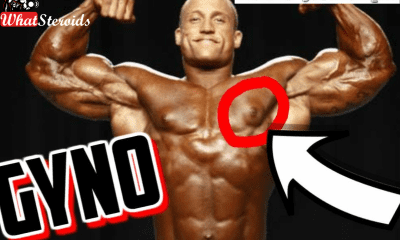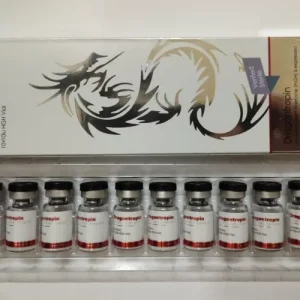Steroids
9 Causes of Gynecomastia and Man Boobs
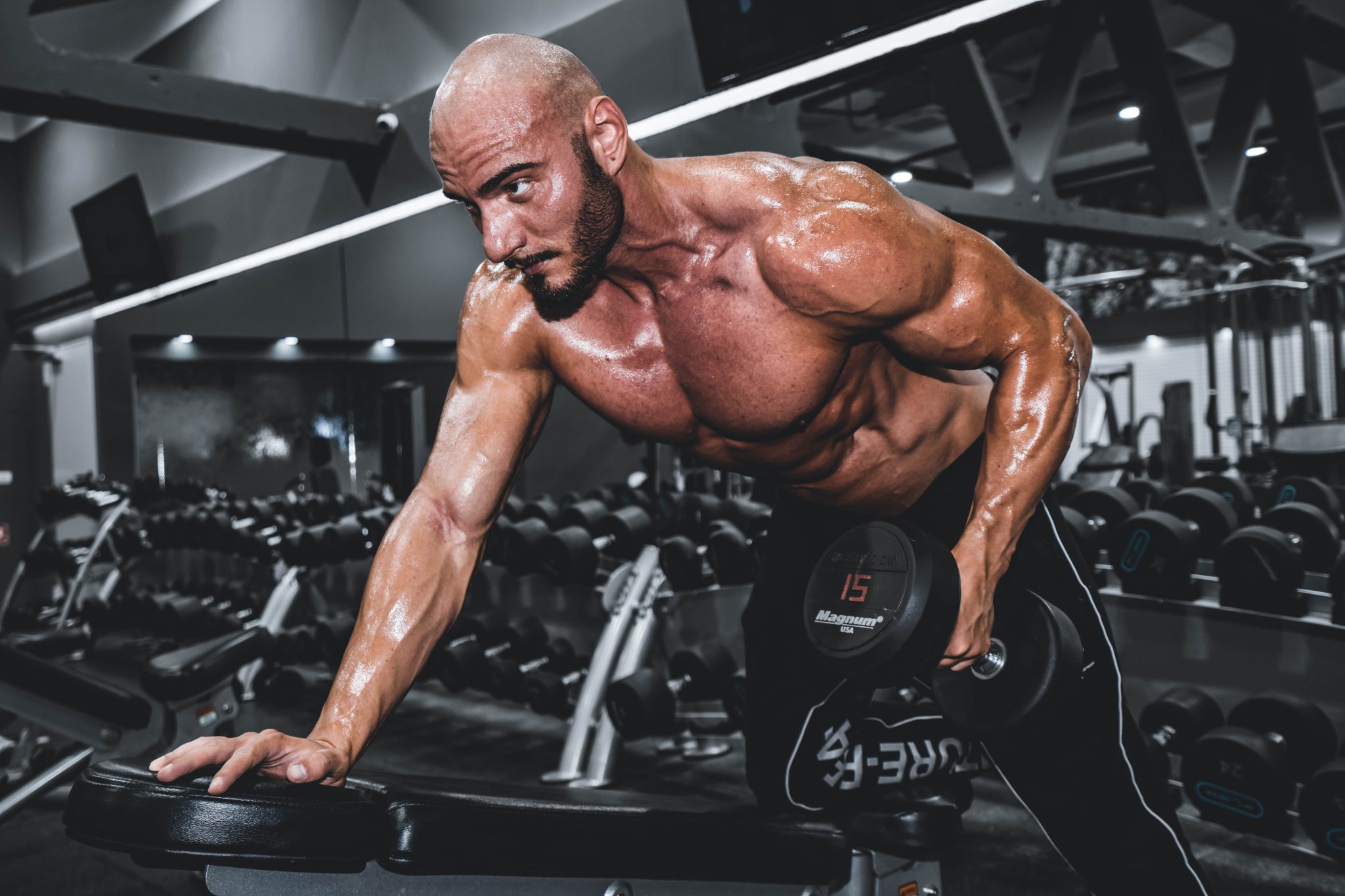
Gynecomastia is an emerging condition in men in the recent times. It can be referred with different names including Male breasts, Man boobs or simply moobs. Although harmless, the condition can cause serious trouble including the risk of developing breast cancer. The condition can easily be avoided although there are genetic causes, which means that the person is born with man boobs. This genetic condition is called Klinefelter Syndrome and less or nothing can be done in such a case.
What actually happens in gynecomastia is that there is an increase in breast tissue, particularly the glandular tissue and not the fat tissue in men. Men usually have breast tissue but not in large amounts as women do. The hormone that brings out this difference, calls estrogen and is usually in high amounts in females than males. Therefore, when a man develops breasts, most likely it will be an increase in the hormone estrogen.
The causes in one or more ways somehow will always point to an imbalance in the hormones estrogen and androgens. Any condition or substance that will lead to an increase in estrogen and a drop in androgens in makes will make them have gynecomastia.
Related Article:: The Effects of Estrogen on Body Composition – Estrogen Dominance
What are indicators of Gynecomastia?
Gynecomastia is a condition, which can easily be self-diagnosed. However, it is always advisable to see a medical specialist for proper medical diagnosis. It can occur in one or both breasts and in most cases; it starts out as a small painful or painless lump beneath the nipple. Eventually, the whole breast enlarges and then that will be gynecomastia. Breasts will enlarge unevenly sometimes. Some of the signs and symptoms include:
- The breast tissue becomes swollen.
- There is breast tenderness.
In some cases, it may be breast cancers causing the swelling. It is important to be able to distinguish between the two. Major differences between breast cancer in men and gynecomastia include:
- Cancer in most cases will be confined on one side while gynecomastia can be on either side.
- Cancer is usually not centered around the nipple unlike most cases of gynecomastia.
- Cancerous breast tissue usually feels hard or firm.
- Cancer have associated dimpling of the skin on the breast, the nipple may retract or some discharges nay be seen coming out and the axillary lymph node may be swollen.
How Gynecomastia is diagnosed?
Proper medical diagnosis of gynecomastia is done by a medical specialized in such a field. It basically involves taking your past medical history including drug use and medication accompanied by a physical examination of your breast tissue. Apart from doing the physical exam, other specialist go ahead to do other tests just in case you have other conditions. The most common tests include:
- Blood tests for example liver functions and even hormone tests.
- Testing of your urine.
- An x-ray of your breast tissue that has in low doses.
- Biopsy of the breast tissue when a suspicion of cancer is raised.
Risk factors of Gynecomastia
Who is likely to get gynecomastia? There are several risk factors that may lead to one getting this condition. Some are related to lifestyle while other are as a result of normal physiological processes. The risk factors implicated in gynecomastia include:
- Male teenagers growing normally are at risk of developing gynecomastia.
- Male infants.
- Aging.
- People exposed to certain diseases.
- Certain medications.
The causes of Gynecomastia
Gynecomastia has so many causes. Here, we highlight the top 9 causes of gynecomastia in men.
1. Obesity
Obesity refers to a situation where there is increased fat content in the body. It can be a cause of Gynecomastia and has been a common one in the recent past where we have had increased cases of obesity all over the world.
So how does obesity come in to cause obesity? It is believed that the increased fat in your body as well as in your breast tissue has a role in disrupting the hormones in your body including the estrogen and the androgen and therefore bringing about gynecomastia. The disruption is carried out because of a hormone called leptin, which increases, in levels when there is increased fat in the body.
In cases of obesity, leptin will rapidly increase in the body and this result in a condition called leptin resistance. Leptin resistance causes the brain to see that the body is starving and it directs its activities in ensuring that the body is getting enough nutrients and that reproduction is not important here. This implies that the hormones for reproduction in males, the androgens are suppressed and there will be a rise in estrogen, which will then cause gynecomastia.
2. Steroids
Perhaps the commonest causes of gynecomastia are the anabolic steroid used by bodybuilders and other athletes. Most if not all anabolic steroids are usually synthetic versions of testosterone. Since the body has the mechanisms of converting testosterone into estrogen, some of these anabolic steroids get converted into estrogen leading to development of gynecomastia.
Steroids >> HERE
Estrogen usually requires in the male body in limited amounts. It has several roles such as helping in maintaining healthy bones, sexual activities and help ensure that the fat content in men is low enough not to cause any health related conditions. However, beyond a certain limit, it comes with associated health risks one of which is gynecomastia.
So apart from causing trouble with your testicles among other side effects of the anabolic steroids, they can really make your life embarrassing by making you develop man boobs, which not every male person would want to be associated with. It is estimated that about half the cases of gynecomastia are as a result of anabolic steroid abuse.
3. Cancers
There are certain types of cancers implicated in causing gynecomastia. Most of the tumors sometimes are usually undetected hence the importance of seeking a proper medical diagnosis. Since gynecomastia is a result of hormone imbalance, these types of cancers must have a part to play in causing the hormonal imbalance.
The major tumors that have been known to have an impact on hormones are the testicular tumors and pituitary tumors (Prolactinoma). These tumors will result in either an increase in production of estrogen or a decrease in production of testosterone.
Testicular tumors for example can result in increased synthesis and production of a hormone called Human chorionic gonadotropin (HCG). HCG closely resembles Luteinizing hormone (LH) both in structures and in function. It therefore will also lead to increased production of testosterone and also the conversion of the produced testosterone to estrogen and that is where trouble comes in.
4. Genetic hereditary disorders
Another common cause of man boobs are some hereditary disorders that one is born with and which most likely run through their families. Klinefelters syndrome is the commonest of the causes. In this condition, an individual has 3 pairs of chromosomes instead of the usual 2 pairs. Normally, a man has the XY chromosome combination. However, in Klinefelters syndrome, there is an additional X chromosome forming the XXY combination.
In such cases, the patients will be sterile and gynecomastia is an outstanding feature. This is a bit hard to manage because it is not easy to change the chromosomal arrangement of a person.
5. Side effects of certain medications
There is a wide range of drugs that have gynecomastia as a side effect of taking them. In fact drugs ranks highly in causing man boobs causing even as high as a quarter of all the causes of gynecomastia. So how do drugs come in when it comes to causing hormonal imbalance, which causes man boobs?
Well, most drugs and especially the ones that are prescribed harbor about three effects that are likely to cause gynecomastia:
- They have an estrogen like activity when taken.
- Can raise the levels of estrogen directly.
- Have androgens as part of them and these androgens can be converted to estrogens.
So, talk about amphetamines, antibiotics or any other common drugs and you will see that they somehow can be the reason why you are developing man boobs. It is good that you get to know the side effects of the drugs you are taking. Talk to your doctor about it and if you develop any signs of increased breast tissue, then you can consider stopping.
Here is a list of the drugs that are commonly known to cause gynecomastia:
- Spironolactone - it is a diuretic substance and contains activities that are opposite to those of androgens.
- Drugs that are calcium channels blockers that are important treating hypertension for example nifedipine.
- Drugs that inhibitors of angiotensin converting enzyme (ACE) also used in treatment of hypertension for example captopril.
- Antibiotics such as metronidazole and isoniazid.
- Drugs used in management of ulcers such as cimetidine and ranitidine.
- Digoxin and diazepam.
6. Abusing alcohol
There are several ways in which alcohol can cause gynecomastia. This happens when one drinks excess alcohol every day. One can be prepared to have grown his belly and also be prepared to have man boons as well.
The first way in which alcohol can cause man boobs is through its damage to the liver. The liver is a very crucial organ in getting rid of hormones and when it is damaged due to alcohol abuse, this activity tends to reduce and eventually stop. One of the hormone that will not be eliminated from the body is estrogen. Over time, estrogen gets to accumulate and its immediate effects includes causing Gynecomastia. Apart from being inefficient in eliminating estrogen, a damaged liver is even more likely to convert the androgens into estrogens.
Apart from damage to the liver, alcohol itself in most cases contain certain compounds that will influence the balance of estrogens and testosterone in the body. The most common compounds found in alcohol are the phyestrogens. Phytoestrogens are basically compounds that mimics the estrogen in the body. How do they get into the alcohol we consume? Well, the hops that use to make beer and also some plants that have a part in making most alcoholic beverages have these compounds in abundant and that is how they end up in the alcohol we consume.
7. Aging
As men age, most of them tend to have an imbalance in their hormonal composition. The first time you may experience gynecomastia is at puberty. During puberty, one produces lots of hormones in high amounts including the estrogens. This is likely to cause man boobs. This is usually not something to worry about since as you leave teenage behind, your hormones come to level and everything goes back to normal. So as long as it does not progress for a long time, there is absolutely nothing to worry about teenage Gynecomastia.
In other cases, you may experience what the experts call idiopathic gynecomastia at some point in life and this may not go away. Idiopathic implies that the growth of the breast tissue cannot simply be traced to the cause. However, there has been some explanations as to why there may be such a case. One common one is that as we men grow, different part of the body also grow including the breast tissue. But the body does not stay in one state all the time and it is likely that the as the body reduced to grow at some point, the breast tissue did not cease for some reasons, hence gynecomastia.
Must Read:: How to Do Bodybuilding Above 50 years Age
As one grows older also, testosterone levels tend to become lower and lower probably because there is less production due to aging of the tissue responsible for its production. This means that estrogens have an upper hand and can now easily cause man boobs. Sometimes older people may have been exposed to some estrogens or something that causes hormonal imbalance without actually having an idea what it was. This might also cause Gynecomastia in old age.
8. Kidney and liver diseases
Another major cause of gynecomastia is severe disease of either the kidney or the liver or even both. These two organs are particularly important in regulating some hormones and other proteins that have a role in preventing development of man boobs.
The liver as seen in alcohol abuse has a major role to play when it comes to giving you gynecomastia if you do not take great care of it. Many conditions that damage the liver are due to alcohol abuse but any other disease that damages the liver including some viral diseases can lead to disruption of normal hormonal elimination hence causing man boobs. Apart from reducing disruption, the liver has a role in regulating synthesis of certain proteins and one crucial protein regulated is the sex hormone binding globulin (SHBG). The SHBG binds testosterone. In severe liver disease, this protein tends to be over produced and will bind more of the testosterone produced. This lowers the amount of testosterone in circulation leading to trouble.
Related Article:: Top 20 Liver Detox Products and Anti-Estrogens on Amazon
Kidney diseases also cause almost a similar situation only that the most severe forms of kidney disease will lead to such a condition. Although man boobs are also a clear symptom, one tends to notice other common symptoms first including abnormal urinary discharges and even skin rashes first before noticing gynecomastia.
9. Smoking Cigarettes And Using Marijuana
Cigarette smoking causes man boobs indirectly. Excessive smoking will lead to development of lung cancers some of which just like the testicular and pituitary tumors will cause a disruption in the hormonal balance and this will lead to gynecomastia. Lung cancers in fact have an upper hand when it comes to causing gynecomastia. All the other cancers that are known to cause hormonal imbalance. The good news is that the lung cancers are a bit more preventable unlike the other forms of cancers.
Apart from cigarettes, Marijuana is another common cause of man boobs. So many people are still not aware of this and therefore sometimes they tend to think that marijuana has no role in this. Using marijuana in excess amounts has the effect of increasing breast tissue in men. Hoe this happens is still a mystery but some studies suggest that marijuana depresses the levels of testosterone.
Other common causes of Gynecomastia
There are still so many other causes of man boobs and here are some of the honorable mentions:
- Depriving yourself of certain nutrition in the name of deprivation diets.
- Drugs used to manage hair losses.
- Plant oils and natural grooming products.
- Testosterone replacement therapy.
- Time in the womb as a fetus.
Read this >> Elucidation of Testosterone Replacement Therapy
Will the Gynecomastia go away?
Having looked at the causes of gynecomastia, you may be wondering how long does one need to have this condition before it goes away. The truth is, it depends on the type and cause of gynecomastia. Pubertal gynecomastia for instance may regress once one is out of puberty. Of course, there are rare cases where such gynecomastia persists in which case there will be need of medical treatment.
Other forms of gynecomastia stay for a longer period of time. Cases have been reported where gynecomastia has lasted for more than 12 months without treatment. If gynecomastia lasts that long, most likely, it will undergo fibrosis and this will complicate treatment.
Related Article:: Steroids, Gynecomastia and GynoSurgery
Treatment of Gynecomastia
There are two major approaches in the treatment and management of gynecomastia. However, gynecomastia in most cases is a condition which will go away on its own within a period of about six months provided that the condition leading to it eliminate as much as possible. If it does not go away, treatment can either be:
- Using drugs.
- Surgical approach.
Using Drugs in Treatment of Gynecomastia
There are several drugs, that we can use in the management of gynecomastia. Their effectiveness has been in question but they are still used. In fact, most if not all of them have not been approved by the FDA. The commonest drugs that have been in use include:
- Testosterone replacement in older men but not younger males who have normal testosterone levels.
- Clomiphene taken for a period of 6 months has also some good results.
Clomiphene Citrate >> HERE
- There has also been the selective estrogen receptor modulator tamoxifen, which works by reducing breast volume. It has also been helpful in cases of severe and painful gynecomastia.
- Danazol, a synthetic derivative of testosterone helps reduce the levels of estrogen in the body by limiting its production by the testis.
TAMOXIFEN >> BUY IT
Surgical Approach in the Treatment of Gynecomastia
Drugs are more effective in the treatment of gynecomastia during the early stages of the condition. However, after a period of about 12 months when the glandular tissue has been transformed into a fibrous tissue, drugs become less effective and only surgery might prove helpful here.
Surgical reduction of the breast tissue refers to as reduction mammoplasty and use it in cases where we have:
- Severe gynecomastia.
- Long term gynecomastia.
- Drugs have failed to bring the condition back to normal.
Prevention of Gynecomastia
Like treatment, prevention of gynecomastia depends on the types of gynecomastia one is talking about or how it is. Gynecomastia caused by hormonal imbalance as a result of for example aging or pubertal changes cannot be prevented. Other forms for example those which are caused by some medical conditions can be prevented. This will be through preventing the underlying conditions such as avoiding abuse of alcohol. Having a clear and sound knowledge of everything to do with Gynecomastia can help you avoid it in the future if it is the kind that can be prevented.
Conclusion
Gynecomastia is a common condition that has been a major cause of concern for men. It so many causes some of which have been highlighted in this article. Gynecomastia can easily be managed and one is bound to have his normal breast composition. It is however, an embarrassing condition and many men have been suffering silently. In case where you have the condition, you can do some of the following things so that you can avoid being depressed:
- Get some counseling from a trusted expert.
- Reach out to the people you love including your friends and family members.
- Connect to people with similar conditions or who have gone through the same condition.
Steroids
AOD-9604: The Fat-Burning Peptide Explained
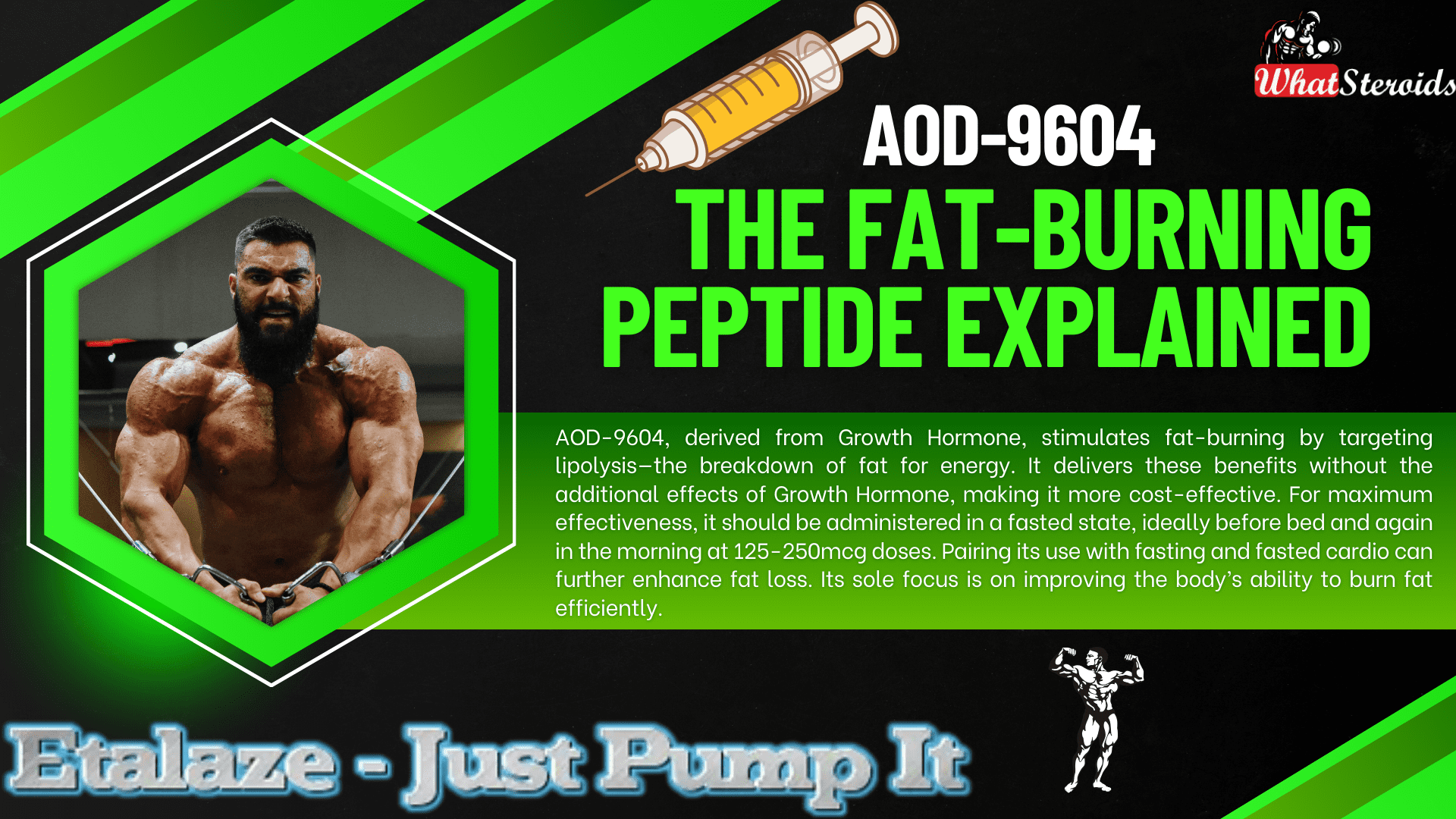
AOD-9604, along with the similar HGH Frag 176-191, is a peptide derived from Growth Hormone that includes only the amino acids in HGH responsible for stimulating fat breakdown, known as lipolysis.
This means that these peptides offer the fat-burning benefits of HGH without its other effects—whether beneficial or adverse—and come at a lower cost.
Related Article: Anavar Cycle for Men and Women
Lipolysis refers to the process where fat cells are broken down to be utilized as energy. AOD-9604 promotes accelerated fat loss by increasing the body's use of fat as fuel.
For optimal results, the peptides should be used in a fasted state. AOD-9604 and Frag 176-191 are most effective when administered at a dose of 125-250mcg before bedtime (at least 3-4 hours after eating) and in the morning at the same dose, followed by a fasting period of 3-4 hours, ideally combined with fasted cardio.
Check Out Dragontropin HGH 100 IU by Dragon Pharma
Similar Peptides with Fat-Burning Effect
Here’s a list of 10 peptides similar to AOD-9604, each with a brief description:
Ipamorelin: A growth hormone-releasing peptide (GHRP) that stimulates the natural release of growth hormone, promoting fat loss, muscle growth, and improved recovery without affecting other hormones like cortisol or prolactin.
CJC-1295: A peptide that increases growth hormone and IGF-1 levels, aiding in fat loss, muscle gain, and improved sleep quality. It has a long half-life, making it convenient for users.
HGH Frag 176-191: A fragment of human growth hormone specifically designed for fat-burning. It targets adipose tissue without the broader effects of full-length HGH.
Tesamorelin: Known for reducing visceral fat, this peptide stimulates the release of growth hormone and is often used for weight management and metabolic health.
BPC-157: While primarily known for healing and recovery, BPC-157 can support fat loss indirectly by improving gut health and reducing inflammation.
Melanotan II: Originally developed for skin tanning, it also has appetite-suppressing properties, making it useful for weight management.
Thymosin Beta-4 (TB-500): Focused on healing and recovery, it can enhance physical performance and indirectly support fat loss through improved activity levels.
GHRP-6: A growth hormone-releasing peptide that boosts appetite and metabolism, aiding in muscle growth and fat loss.
Semaglutide: A GLP-1 receptor agonist that regulates appetite and blood sugar levels, making it effective for weight loss and metabolic health.
MK-677 (Ibutamoren): A growth hormone secretagogue that increases growth hormone and IGF-1 levels, promoting fat loss, muscle gain, and improved recovery.
List of Peptides With a Counteractive Effect Bodybuilders Must Avoid
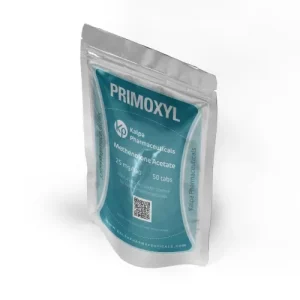 Click Here to Buy Primoxyl 25 by Kalpa Pharmaceuticals
Click Here to Buy Primoxyl 25 by Kalpa Pharmaceuticals
Some peptides can inadvertently lead to fat gain due to their effects on metabolism and appetite regulation. Here are a few that bodybuilders might want to avoid or use cautiously:
- GHRP-6 – While it stimulates growth hormone release, it also significantly increases appetite, which can lead to excess calorie consumption and fat gain.
- IGF-1 LR3 – This peptide enhances muscle growth but can also promote fat storage if not carefully managed with diet and training.
- MK-677 (Ibutamoren) – Though technically a growth hormone secretagogue rather than a peptide, it boosts GH levels but often leads to increased hunger and potential fat accumulation.
- CJC-1295 with DAC – While effective for muscle growth, its prolonged GH release can sometimes lead to unwanted fat retention if not paired with a strict diet
Overall
AOD-9604, derived from Growth Hormone, stimulates fat-burning by targeting lipolysis—the breakdown of fat for energy. It delivers these benefits without the additional effects of Growth Hormone, making it more cost-effective. For maximum effectiveness, it should be administered in a fasted state, ideally before bed and again in the morning at 125-250mcg doses. Pairing its use with fasting and fasted cardio can further enhance fat loss. Its sole focus is on improving the body’s ability to burn fat efficiently.
Read More: How Much Do You Know About B-AET? A Fat Burner You’ve Been Missing
Bodybuilding
Understanding Trenbolone-Induced Cough (“Tren Cough”)

Trenbolone, a potent anabolic steroid, can sometimes cause “tren cough”—a sudden and intense coughing episode shortly after injection. Although not exclusive to Trenbolone, it is more commonly associated with this substance due to its highly irritant nature.
 Click Here To Buy 1-Test Cyp 100 by Nakon Medical
Click Here To Buy 1-Test Cyp 100 by Nakon Medical
Mechanisms Behind Tren Cough
Solvent and Carrier Irritation
Trenbolone formulations often include volatile solvents like benzyl alcohol or benzyl benzoate, which may irritate lung tissues when absorbed quickly into systemic circulation.
Prostaglandin Release
Trenbolone promotes increased production of prostaglandins, particularly PGF2α. This compound triggers contraction in the smooth muscles of the lungs, leading to bronchoconstriction and coughing.
Micro-Oil Embolism
Tiny oil droplets from an injection can reach capillaries and travel to the lungs, causing mild embolic reactions that lead to temporary oxygen deprivation and coughing.
Histamine and Mast Cell Activation
For some individuals, Trenbolone triggers histamine release and mast cell activation, mimicking an allergic response and causing bronchospasms and cough reflexes.
Related Article: Best Syringes for Steroid Injection on Amazon
Using Salbutamol (Albuterol) to Manage Tren Cough
- Salbutamol, a widely-used β2-adrenergic receptor agonist, can alleviate tren cough symptoms by:
- Relaxing bronchial muscles, easing spasms that cause coughing.
- Inhibiting prostaglandin effects, reducing bronchoconstriction associated with PGF2α.
- Opening airways, preventing severe respiratory restrictions in susceptible individuals.
Application Methods
Inhaler (Optimal)
Take 1–2 puffs of salbutamol (100–200 mcg) 5–10 minutes before a Trenbolone injection. If coughing occurs afterward, additional puffs can swiftly resolve the issue.
Oral Tablets (Moderate)
Consuming 2–4 mg tablets 30–60 minutes before injection offers slower, longer-lasting relief but may be less effective than inhalation methods.
Nebulizer (Severe Cases)
For individuals with frequent episodes, nebulized doses of 2.5 mg salbutamol can provide substantial relief.
Preventive Measures to Reduce Tren Cough Risk
- Inject slowly to minimize systemic absorption and irritant effects.
- Split doses to lower reaction severity with smaller quantities.
- Opt for ventrogluteal injection sites, which have fewer blood vessels, reducing oil embolism risk.
- Choose lower-concentration solutions to lessen irritation, as higher concentrations (e.g., Tren Ace 200 mg/ml) are more likely to provoke reactions.
What Other Steroids Can Induce Coughing?
Here's a curated list of peptides, SARMs, and PEDs that may potentially cause coughing or respiratory irritation in bodybuilders and fitness enthusiasts:
Peptides
IGF-1 LR3 (Insulin-like Growth Factor): Known for its anabolic effects, IGF-1 LR3 can occasionally cause mild respiratory irritation due to systemic absorption.
TB-500 (Thymosin Beta-4): While rare, improper injection techniques or high doses may lead to transient coughing episodes.
GHRP-6 (Growth Hormone-Releasing Peptide): This peptide can stimulate histamine release, potentially leading to bronchospasms and coughing.
SARMs (Selective Androgen Receptor Modulators)
RAD-140: (Testolone) Some users report throat irritation or coughing, often attributed to solvents used in liquid formulations.
YK-11: Known for its myostatin-inhibiting properties, YK-11 may cause mild respiratory discomfort in sensitive individuals.
LGD-4033 (Ligandrol): Though uncommon, some users experience coughing due to carrier solvents or allergic-like reactions.
PEDs (Performance-Enhancing Drugs)
Boldenone Undecylenate (Equipoise): This injectable steroid can cause “Equipoise cough,” similar to tren cough, due to oil embolism or irritant solvents.
Testosterone Suspension: The water-based formulation may lead to coughing episodes if injected improperly or absorbed rapidly.
Nandrolone Decanoate (Deca-Durabolin): While less common, coughing can occur due to histamine release or systemic irritation.
More Tips to Minimize Coughing Risks
- Use proper injection techniques to avoid embolic reactions.
- Opt for lower-concentration solutions to reduce irritant effects.
- Consider antihistamines or bronchodilators for individuals prone to respiratory sensitivity.
Read More: Joint Stiffness: How to Manage It While on AAS
Are There Alternatives to Cough-inducing Steroids?
Here are some alternatives to cough-inducing steroids that can provide similar anabolic effects while minimizing respiratory irritation:
Peptides
IGF-1 LR3 (Insulin-like Growth Factor)
Promotes muscle growth and recovery without the irritant properties of certain steroids.
TB-500 (Thymosin Beta-4)
Enhances tissue repair and reduces inflammation, making it a safer option for recovery.
BPC-157 (Body Protection Compound)
Known for its healing properties, it supports muscle repair and joint health.
SARMs (Selective Androgen Receptor Modulators)
RAD-140 (Testolone)
Provides significant muscle-building effects with fewer systemic side effects compared to traditional steroids.
LGD-4033 (Ligandrol)
Boosts lean muscle mass and strength without the risk of respiratory irritation.
MK-677 (Ibutamoren)
Stimulates growth hormone release, aiding in muscle growth and recovery.
Natural Alternatives
Turkesterone
A plant-based ecdysteroid that supports muscle protein synthesis and recovery.
Ecdysterone
Another natural compound that mimics anabolic effects without the harsh side effects.
Creatine Monohydrate
Enhances strength and muscle mass through improved energy production during workouts.
Other Options
Human Growth Hormone (HGH)
Promotes muscle growth and fat loss, though it requires careful monitoring due to potential side effects.
Testosterone Boosters
Natural supplements like D-Aspartic Acid or Tribulus Terrestris can help optimize testosterone levels for muscle growth.
SARMs Alternatives
Legal and safer versions of SARMs are available, offering similar benefits without the risks associated with traditional SARMs.
Overall
We have explored the phenomenon of "tren cough," a sudden, intense coughing episode often caused by Trenbolone injections due to factors like solvent irritation, prostaglandin release, micro-oil embolism, or histamine activation. Preventive measures such as using salbutamol (via inhaler, oral tablets, or nebulizer), injecting slowly, splitting doses, and opting for lower-concentration solutions were highlighted.
Additionally, alternative compounds to tren cough-inducing steroids were discussed, including peptides like IGF-1 LR3 and TB-500, SARMs such as RAD-140 and LGD-4033, and natural options like Turkesterone, ecdysterone, and creatine. These alternatives provide anabolic effects while minimizing respiratory side effects. The conversation also underscored the importance of proper injection techniques and thoughtful compound selection to reduce risks.
Steroids
Creatine vs Myostatin: An Expert’s Analysis

Myostatin, a protein encoded by the MSTN gene, acts as a regulator of muscle growth. High levels of myostatin limit the body's ability to build muscle, effectively putting a cap on potential hypertrophy. Inhibiting myostatin has become a focal point for bodybuilders looking to break through plateaus and achieve significant muscle gains. The question is: can creatine, a popular and widely available supplement, help in this regard?
Medical History of Myostatin and Creatine
Myostatin and creatine, while popular now in the bodybuilding world, have their roots in entirely different contexts:
Myostatin: Natural Muscle Growth Regulator
Myostatin is a protein originally identified for its role in regulating skeletal muscle mass. In nature, it serves an evolutionary purpose: by limiting muscle growth, it conserves energy, ensuring that animals (and humans) don’t expend unnecessary resources maintaining excessive muscle tissue. This was especially important in the wild, where energy efficiency could mean the difference between survival and extinction.
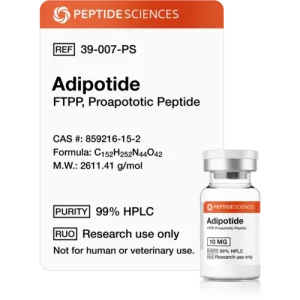 Check Adipotide (FTPP) 10mg by Peptide Science
Check Adipotide (FTPP) 10mg by Peptide Science
In the medical field, research into myostatin has focused on its role in muscle-wasting diseases. Scientists are exploring ways to inhibit myostatin to treat conditions like muscular dystrophy, where excessive muscle loss impairs quality of life. This therapeutic potential is where the idea of myostatin inhibition first began—long before bodybuilders latched onto the concept.
Creatine: Energy and Medical Applications
Creatine was originally studied for its role in energy metabolism. It’s a naturally occurring compound stored in muscle cells and plays a critical part in replenishing ATP (adenosine triphosphate), the body’s primary energy currency during short, high-intensity activities.
Before becoming a bodybuilding staple, creatine gained recognition in medical and sports science for its ability to improve athletic performance and assist with recovery. Furthermore, in medicine, creatine was investigated for neurological conditions such as Parkinson’s disease, Huntington’s disease, and muscular dystrophy, given its potential to improve muscle function and brain energy metabolism.
In the sports world, it was initially adopted by sprinters and weightlifters in the 1970s and 1980s for its energy-enhancing benefits.
Both myostatin and creatine have found new life in bodybuilding circles, demonstrating how discoveries in natural physiology and medical science can lead to transformative applications in fitness.
Benefits of Creatine as a Myostatin Inhibitor
Muscle Growth Potential: Research suggests that creatine, when paired with intense resistance training, may inhibit myostatin to a degree, fostering an environment for enhanced muscle growth.
Improved Exercise Performance: Creatine is well-known for its ability to increase ATP production, translating to better performance during high-intensity activities.
Versatility Across Fitness Levels
Whether you're a beginner or an advanced athlete, creatine offers benefits that complement various stages of muscle-building.
Must Read: A New Caffeine? What You Need to Know about Teacrine
Affordability and Accessibility
Compared to specialized myostatin inhibitors like YK-11 and ACE-031, creatine is significantly more affordable and accessible.
Side Effects of Creatine
While generally safe for most individuals, creatine supplementation does come with some potential side effects:
Water Retention: Some users experience bloating due to increased water retention in muscle cells.
Gastrointestinal Issues: High doses may lead to stomach upset or diarrhea.
Kidney Concerns: Although rare, prolonged excessive use could strain the kidneys, particularly in individuals with pre-existing conditions.
 Buy Methyl-1-Test 10 -100 tabs by Dragon Pharma
Buy Methyl-1-Test 10 -100 tabs by Dragon Pharma
Alternatives to Creatine for Myostatin Inhibition
YK-11: A synthetic myostatin inhibitor derived from SARMs, offering more potent results but accompanied by more significant risks.
ACE-031: A peptide that directly inhibits myostatin, though it remains in experimental phases and is not legally approved in many regions.
Natural Alternatives
Follistatin-rich Foods: Eggs and dairy products may have natural myostatin-inhibiting properties.
Resistance Training: Intense and consistent weightlifting alone can naturally lower myostatin levels.
Where to Buy Creatine
Creatine is readily available worldwide. It can be purchased from:
Local Pharmacies and Nutrition Stores: Ideal for trusted and immediate access.
Online Platforms: Websites like Amazon, iHerb, or bodybuilding-specific stores offer a variety of brands and formulations.
Supplement Brands: Well-established brands such as Optimum Nutrition, MyProtein, and Cellucor often carry high-quality creatine.
Legality of Myostatin Inhibitors
Creatine: Creatine is completely legal and widely accepted as a dietary supplement.
YK-11 and ACE-031: These compounds exist in a legal gray area in many countries due to their experimental nature and potential risks. It's essential to research local laws before considering these options.
Best Stores and Suppliers
For reputable products, consider:
Transparent Labs: Known for purity and transparent labeling.
Optimum Nutrition: Offers pharmaceutical-grade creatine monohydrate.
Bulk Supplements: A great choice for bulk buyers seeking affordability and quality.
Our Advice to Bodybuilders
Always consult with a healthcare professional before starting any new supplement, especially if you are already using AAS or other advanced compounds.
Prioritize a balanced diet and consistent exercise routine. Supplements like creatine work best as part of a holistic approach to fitness.
Stay hydrated while using creatine to minimize water retention side effects and support kidney health.
Related Article: Best Syringes for Steroid Injection on Amazon
Overall
While creatine may not be as potent a myostatin inhibitor as advanced compounds like YK-11 or ACE-031, its affordability, safety, and accessibility make it a valuable addition to any bodybuilder's supplement stack. By leveraging its benefits alongside proper training and nutrition, you can maximize muscle growth and overcome plateaus, regardless of your fitness level.
-

 Steroids2 years ago
Steroids2 years agoShavers and Other Body Grooming Equipment for Bodybuilders In 2023
-

 Steroids2 years ago
Steroids2 years agoChatGPT and Other Avenues to Find Great Bodybuilding Coaches
-

 Steroids2 years ago
Steroids2 years agoBest Oil Recommendations Before Competition for Subtle Shimmer
-

 Steroids2 years ago
Steroids2 years agoPowerlifting Vs Power Building: Find Out the Big Difference and When to Shift Between the Two
-

 Nutrition1 year ago
Nutrition1 year agoEverything Nutritional Food: What’s Too Much Or Too Little
-

 Bodybuilding Products1 year ago
Bodybuilding Products1 year agoTelmisartan In Bodybuilding: An Expert’s Advice
-

 Anabolic Steroids1 year ago
Anabolic Steroids1 year agoLegality of Anabolic Steroids In Latin America
-

 Beginners2 years ago
Beginners2 years agoTren Cycle for Beginners
-

 Bodybuilding1 year ago
Bodybuilding1 year agoList of FDA-Approved Peptides
-

 Bodybuilding1 year ago
Bodybuilding1 year agoChia Seeds in A Bodybuilder’s Diet: An Expert’s Advice
-

 Bodybuilding2 years ago
Bodybuilding2 years agoCompetition Prep Cycle for Pro Bodybuilders
-

 Anabolic Steroids9 months ago
Anabolic Steroids9 months agoJoint Stiffness: How to Manage It While on AAS
-

 Bodybuilding8 months ago
Bodybuilding8 months agoPrimal Movements: Our Ultimate Guide for Maximum Results
-

 Steroids12 months ago
Steroids12 months agoAnadrol Cycle: Benefits, Doses, Alternatives, etc.
-

 Bodybuilding8 months ago
Bodybuilding8 months agoHow Effective is Bone Broth for Recovery?
-

 Steroids10 months ago
Steroids10 months agoOmnitope (Oxytocin)
-

 Bodybuilding1 year ago
Bodybuilding1 year agoHow Much Is Too Much Cardio? Understanding Heart Rate Zones
-

 Anabolic Steroids11 months ago
Anabolic Steroids11 months agoHow Much Do You Know About B-AET? A Fat Burner You’ve Been Missing
-

 Steroids9 months ago
Steroids9 months agoSleeping Positions for Effective Muscle Recovery
-

 Bodybuilding1 year ago
Bodybuilding1 year agoCalorie Dumping: A Bodybuilder’s Guide
-

 Product Reviews11 months ago
Product Reviews11 months agoTop Vitamins for Skin Health
-

 Bodybuilding8 months ago
Bodybuilding8 months ago2nd Edition of Natural Bodybuilding Competition Facts
-

 Bodybuilding1 year ago
Bodybuilding1 year agoDemystifying Hypertrophy Training
-

 Bodybuilding8 months ago
Bodybuilding8 months agoAre Nootropics a Better Option to AAS?
-

 Steroids11 months ago
Steroids11 months agoMajor Bodybuilding Peptides Explained


